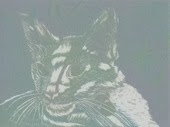Marian Carter
When I am not working as an Art Technician in a large secondary school I am a print-maker.
I
originally trained as a graphic designer in the early 1980s then, about
fourteen years ago,
I decided to attend a course in printmaking at Amersham
college where I learnt various techniques including etching, dry point and lino
cutting, but for some years it was printing collagraphs that really fascinated
me. I bought a small press and continued printmaking at home with limited
success selling a few prints through local galleries.
Several
years ago I had the good fortune to meet another printmaker, Helen Boden, and began
attending regular printmaking sessions one day a week at her studio in Chesham.
www.bodenpress.co.uk
Helen taught me reduction lino printing and I have become a little obsessed
with this.
I
think it particularly lends itself to my preferred subject matter, animals and
birds.
The cutting seems to be especially effective in portraying feathers and
fur.
A
trip to Kenya a few years ago yielded huge inspiration for more prints. The
patterns on the birds and animals particularly interested me, be it spots on
leopards, stripes on zebras or beautiful combinations of both on vulturine
guinea fowl.
Reduction
lino printing requires accurate cutting, very careful registration and a lot of
patience as it can be quite a long process.
Like
a lot of printmaking I find it brings the greatest highs; nothing beats the
pleasure of pulling a really good reduction lino print off the press.
Unfortunately on bad days there is the huge disappointment of pulling a truly
terrible print off the press too!
On
the whole though I find the good printmaking days far outweigh the bad and I
can thoroughly recommend it as a fascinating process.
I
am a member of the BBH and exhibit with them regularly. I also exhibit as a
member of Boden Press at One Church Street Gallery in Great Missenden and at Bucks
Open Studios. I also sell my work through other galleries sometimes
independently.
I now work from a beautiful, light print studio in my garden.
Please have a look at my website for more images and information.
www.mariancarterart.co.uk
Reduction Lino Printing by Marian
Carter
Reduction Lino printing is a process whereby a single lino plate is used
to create a limited edition of prints.
The plate is prepared by cutting with
lino cutting tools. The relief is inked up with a roller and then printed by
running through an etching press or using an Albion press.
The process is to produce an image using many layers of colour by
cutting away areas on the plate that are to have a particular colour in the
finished work, print a colour and then repeat the process for each colour until
all desired colours are printed. By way of illustration, these are the steps I
took to produce ‘White Cat, Dappled Light’.
1. The first stage was to cut away any areas that I wanted to
remain white. I then inked up the plate with first colour I chose, in this case
pink, and printed the image as below:
1. I then cut away any areas that I wanted to remain pink.
I inked up the plate with the second colour which, in this example, is blue and
printed this blue on the image printed from stage 1 above. This gave:
3. This time I cut away the areas that I wanted to stay blue and inked up the plate with my third
colour of green. I then printed the green on the prints from stage 2 with the
following result:
4. I repeat the process for the fourth colour which in this
case is lilac. It now appears as:
5.
Finally,I repeated it for my last colour of brown giving the finished print like this:
Registration is the process of lining up the paper on which the print is being
made so that the successive images in stages one to five all align; this is a
crucial process.

A number of small techniques make this easier: I have an
outline of the plate marked on a sheet of plastic which lies on the bed of the
press meaning I can position the plate in the same place for each colour. I use
pieces of card taped down to mark the position of the paper and I then trap the
paper in the roller after aligning it with the markers to prevent it moving.
Getting
the sequence of colours right is also important and opaque colours on
transparent colours can be used to give different effects. Acetate masks can
also be used if strong colours are wanted but not to cover the whole plate.
The nature of reduction lino printing is that it is ‘destructive’ in that as
the plate is progressively cut between colours it is impossible to go produce
further prints once a run is complete. I generally print small editions of
eight prints.













